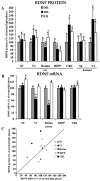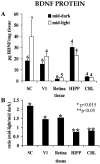Effects of early visual experience and diurnal rhythms on BDNF mRNA and protein levels in the visual system, hippocampus, and cerebellum
- PMID: 11356880
- PMCID: PMC6762725
- DOI: 10.1523/JNEUROSCI.21-11-03923.2001
Effects of early visual experience and diurnal rhythms on BDNF mRNA and protein levels in the visual system, hippocampus, and cerebellum
Abstract
The expression of brain-derived neurotrophic factor (BDNF) mRNA and the secretion of BDNF protein are tightly regulated by neuronal activity. Thus, BDNF has been proposed as a mediator of activity-dependent neural plasticity. Previous studies showed that dark rearing (DR) reduces BDNF mRNA levels in the primary visual cortex (V1), but the effects of visual experience on BDNF protein levels are unknown. We report that rearing in constant light or DR alters BDNF mRNA and protein levels in the retina, superior colliculus (SC), V1, hippocampus (HIPP), and cerebellum (CBL), although the changes in mRNA and protein are not always correlated. Most notably, DR increases BDNF protein levels in V1 although BDNF mRNA is decreased. BDNF protein levels also undergo diurnal changes. In the retina, V1, and SC, BDNF protein levels are higher during the light phase of the circadian cycle than during the dark phase. By contrast, in HIPP and CBL, the tissue concentration of BDNF protein is higher during the dark phase. The discrepancies between the experience-dependent changes in BDNF mRNA and protein suggest that via its effects on neuronal activity, early sensory experience alters the trafficking, as well as the synthesis, of BDNF protein. The circadian changes in BDNF protein suggest that BDNF could cause the diurnal modulation of synaptic efficacy in some neural circuits. The fluctuations in BDNF levels in nonvisual structures suggest a potential role of BDNF in mediating plasticity induced by hormones or motor activity.
Figures




Similar articles
-
Complexity in the modulation of neurotrophic factor mRNA expression by early visual experience.Brain Res Dev Brain Res. 2003 Jul 12;143(2):225-32. doi: 10.1016/s0165-3806(03)00153-6. Brain Res Dev Brain Res. 2003. PMID: 12855194
-
A phase advance of the light-dark cycle stimulates production of BDNF, but not of other neurotrophins, in the adult rat cerebral cortex: association with the activation of CREB.J Neurochem. 2008 Sep;106(5):2131-42. doi: 10.1111/j.1471-4159.2008.05565.x. Epub 2008 Jul 12. J Neurochem. 2008. PMID: 18636983
-
Mismatch between BDNF mRNA and protein expression in the developing visual cortex: the role of visual experience.Eur J Neurosci. 2001 Feb;13(4):709-21. doi: 10.1046/j.0953-816x.2000.01436.x. Eur J Neurosci. 2001. PMID: 11207806
-
Rapid regulation of brain-derived neurotrophic factor mRNA within eye-specific circuits during ocular dominance column formation.J Neurosci. 2000 Feb 15;20(4):1470-83. doi: 10.1523/JNEUROSCI.20-04-01470.2000. J Neurosci. 2000. PMID: 10662837 Free PMC article.
-
Pleiotropic effects of BDNF on the cerebellum and hippocampus: Implications for neurodevelopmental disorders.Neurobiol Dis. 2022 Feb;163:105606. doi: 10.1016/j.nbd.2021.105606. Epub 2021 Dec 30. Neurobiol Dis. 2022. PMID: 34974125 Review.
Cited by
-
Targeting the circadian modulation: novel therapeutic approaches in the management of ASD.Front Psychiatry. 2024 Oct 11;15:1451242. doi: 10.3389/fpsyt.2024.1451242. eCollection 2024. Front Psychiatry. 2024. PMID: 39465045 Free PMC article. Review.
-
Neurotropic activity of ACTH(7-10)PGP, an analog of an ACTH fragment.Dokl Biol Sci. 2011 Sep-Oct;440:270-4. doi: 10.1134/S0012496611050140. Epub 2011 Dec 2. Dokl Biol Sci. 2011. PMID: 22134808 No abstract available.
-
BDNF and activity-dependent synaptic modulation.Learn Mem. 2003 Mar-Apr;10(2):86-98. doi: 10.1101/lm.54603. Learn Mem. 2003. PMID: 12663747 Free PMC article. Review.
-
TrkB receptor signaling regulates developmental death dynamics, but not final number, of retinal ganglion cells.J Neurosci. 2003 Nov 5;23(31):10137-45. doi: 10.1523/JNEUROSCI.23-31-10137.2003. J Neurosci. 2003. PMID: 14602830 Free PMC article.
-
Phase advance of the light-dark cycle perturbs diurnal rhythms of brain-derived neurotrophic factor and neurotrophin-3 protein levels, which reduces synaptophysin-positive presynaptic terminals in the cortex of juvenile rats.J Biol Chem. 2011 Jun 17;286(24):21478-87. doi: 10.1074/jbc.M110.195859. Epub 2011 Apr 28. J Biol Chem. 2011. PMID: 21527636 Free PMC article.
References
-
- Altar CA, Cai N, Bliven T, Juhasz M, Conner JM, Acheson AL, Lindsay RM, Wiegand SJ. Anterograde transport of brain-derived neurotrophic factor and its role in the brain. Nature. 1997;389:856–860. - PubMed
-
- Androutsellis-Theotokis A, McCormack WJ, Bradford HF, Stern GM, Pliego-Rivero F. The depolarisation-induced release of [125I]BDNF from brain tissue. Brain Res. 1996;743:40–48. - PubMed
-
- Bear MF, Cooper LN, Ebner FF. A physiological basis for a theory of synapse modification. Science. 1987;237:42–48. - PubMed
Publication types
MeSH terms
Substances
Grants and funding
LinkOut - more resources
Full Text Sources
Miscellaneous
